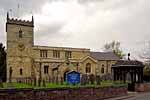 East Bridgford East Bridgford
St Peter
Stonework
Four principal stones have been used in the fabric of St Peter’s. They
are:
aThe nave,
aisles and chancel are constructed from the Triassic Mercia Mudstone group
which are thin beds of hard fine-grained sandstone known as skerries. This
skerry stone was widely used for rubble-wall material including the Roman fort
of Margidunum close by. Very common in the Trent Valley area, it was probably
collected from the fields, or from shallow pits as it lies about one metre
below ground level. Grey-green in colour, its hardness meant it was not amenable
to working, and the pieces of stone were used as they were without shaping.
This hardness has meant there has been little erosion. This stone has also
been used quite extensively as footings for more substantial brick or timber
buildings in East Bridgford.
bThe tower,
quoins and other ashlar work are Triassic Sherwood sandstone, which, being
softer, can be shaped more readily into blocks. Probably quarried between Gedling
and Sneinton, it is pock marked by the erosion of soft clay clasts, a characteristic
of fluvial Triassic sandstones.
cThe window
and door mouldings of the church are Lincolnshire limestone, probably quarried
at Ancaster. This Jurassic middle lias stone ranges in colour from pale to
darker yellow, depending on its iron content. Oolitic and shelly, it is suitable
for carving, but being soft it shows evidence of considerable erosion on the
hood moulding and orders of the south porch and priest’s door in the
chancel.
dAbove
the window heads in the chancel south wall, the east end and about the vestry
door in the chancel north wall, lower Jurassic lias stone has been used as
a decorative feature. This can be found in many Nottinghamshire churches.
A small amount of stone which is not local has been used in the Tower parapet.
This is Coxbench from Derbyshire. The roof of the church is Welsh slate from
Penrhyn.
|